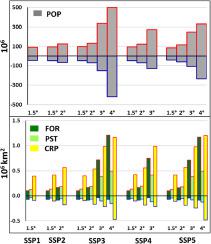Global and Planetary Change ( IF 4.0 ) Pub Date : 2021-08-04 , DOI: 10.1016/j.gloplacha.2021.103597 Jonathan Spinoni 1 , Paulo Barbosa 1 , Michael Cherlet 1 , Giovanni Forzieri 1 , Niall McCormick 1 , Gustavo Naumann 1 , Jürgen V. Vogt 1 , Alessandro Dosio 1

|
One of the possible consequences of projected global warming is the progressive enlargement of drylands. This study investigates to what extent population and land-use (forests, pastures, and croplands) are likely to be in areas turning arid in the 21st century. The first part of the study focuses on the climatological enlargement of arid areas at global, macro-regional, and high-resolution (0.44°) scales. To do so we analysed a large ensemble of CORDEX climate simulations, combined three indicators (FAO-UNEP aridity index, Köppen-Geiger climate classification, and Holdridge life zones), and quantified the areas turning from climatologically not arid into climatologically arid (and vice-versa) from recent past (1981–2010) to four projected global warming levels (GWLs) from 1.5°C to 4°C. In the second part, we used population and land-use projections to analyze their exposure to progressive shifts to drier or wetter climate. Both types of projections follow five socio-economic scenarios (SSPs from SSP1 to SSP5). We present results for the viable combinations between SSPs and GWLs. Depending on GWL, the projected drying patterns show regional differences but, overall, the negative consequences of climate change are clear. Already at 1.5°C warming, approximately 2 million km2 (1.4% of global land) are likely to become arid; at 2°C this area corresponds to 2.6 million km2 (2.7%), at 3°C to 5.2 million km2 (3.5%), and at 4°C to 6.8 million km2 (4.5%), an area that can be ranked the seventh largest country in the World. Such drying is particular strong over South America and southern Europe. In the worst-case scenario (SSP3, regional rivalry, at 4°C), approximately 500 million people will live in areas shifting towards arid climate. Forest areas are likely to be more affected in South America, pastures in Africa, and croplands in the Northern Hemisphere. For land-use, the worst-case scenarios are SSP3 and SSP5 (fossil-fuel based future): at GWL 4°C, about 0.5 million km2 of forests and 1.2 million km2 of both pastures and croplands are likely to be in areas shifting to arid climate.
中文翻译:

21 世纪全球干旱地区的逐步增加将如何影响人口和土地利用?
预计全球变暖的可能后果之一是旱地逐渐扩大。本研究调查了 21世纪干旱地区的人口和土地利用(森林、牧场和农田)可能达到的程度世纪。研究的第一部分侧重于干旱地区在全球、宏观区域和高分辨率(0.44°)尺度上的气候扩大。为此,我们分析了大量 CORDEX 气候模拟,结合了三个指标(FAO-UNEP 干旱指数、Köppen-Geiger 气候分类和 Holdridge 生命区),并量化了从气候学上不干旱到气候学上干旱的地区(以及副-相反)从最近(1981-2010 年)到四个预计的全球变暖水平 (GWL),从 1.5°C 到 4°C。在第二部分中,我们使用人口和土地利用预测来分析他们对干燥或潮湿气候逐渐转变的暴露程度。两种类型的预测都遵循五种社会经济情景(从 SSP1 到 SSP5 的 SSP)。我们展示了 SSP 和 GWL 之间可行组合的结果。根据 GWL,预计的干燥模式显示出区域差异,但总体而言,气候变化的负面影响是显而易见的。已经升温 1.5°C,大约 200 万公里2(占全球土地的 1.4%)可能会变得干旱;在2℃下此区域对应于2600000公里2(2.7%),在3℃至5200000公里2(3.5%),并在4℃至6800000公里2(4.5%),一个区域,可以成为世界第七大国。这种干燥在南美和南欧尤为严重。在最坏的情况下(SSP3,区域竞争,4°C),大约 5 亿人将生活在向干旱气候转变的地区。南美洲的森林地区、非洲的牧场和北半球的农田可能受到的影响更大。对于土地使用,最坏的情况是 SSP3 和 SSP5(基于化石燃料的未来):在 GWL 4°C,约 50 万公里2森林和1200000公里2两的牧场和耕地很可能是在转移到干旱气候区。











































 京公网安备 11010802027423号
京公网安备 11010802027423号